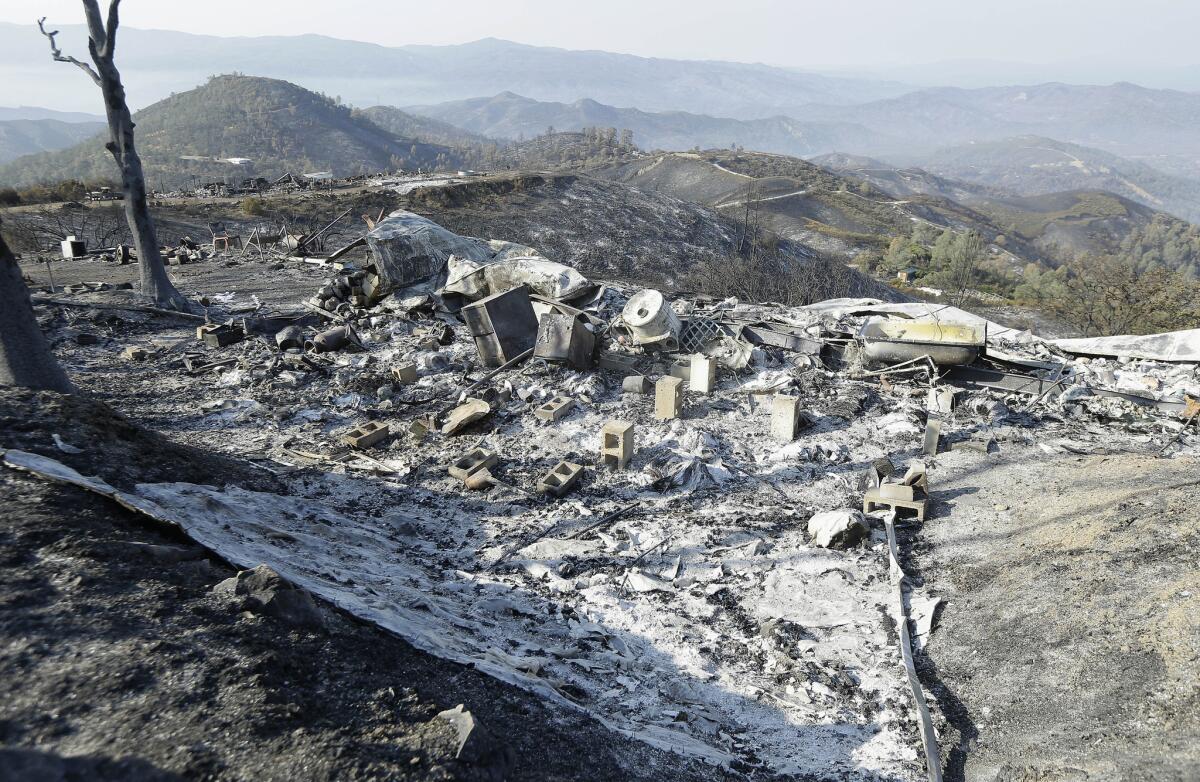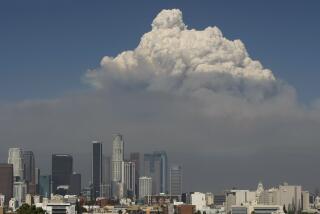Op-Ed: Why we need to learn to live with fire instead of fighting it

The charred remains of a property near Clearlake, Calif., are seen on Aug. 6. Federal, state, and county fire agencies currently spend almost $5 billion a year fighting fires.
The 2015 fire season is poised to become among the worst in American history. More than 6 million acres have burned nationwide, most of that in Alaska and the Pacific Northwest, and the season has just come into its prime in drought-plagued California, where more than 50 blazes have prompted the evacuation of thousands of residents. By the end of summer, thousands of firefighters will have risked their lives and billions of dollars will have been spent in an attempt to control the flames. Despite the effort, towns and watersheds may well turn to ash.
We created our fire problem, and virtually everything we’re doing to combat it only makes it worse.
Most Western forests grew up alongside frequent low-intensity fires that burned saplings and brush in the understory and left behind the oldest and largest trees — those capable of surviving the heat. But for the last 100 years we’ve dealt with blazes by putting them out. Extinguishing fires that once thinned out the vegetation in flame-adapted landscapes has left forests incredibly dense. At some places in the Sierra foothills, there are a thousand trees per acre where just 150 was the historic norm. The extra fuel has created monstrous blazes, such as the 2013 Rim fire that burned 250,000 acres around Yosemite National Park, or the Yarnell Hill fire that same year, which killed 19 firefighters and burned nearly 130 homes in Arizona.
Not only is our approach to handling fires ineffective, it’s expensive: federal, state and county fire agencies spend almost $5 billion a year to stem the destruction. The U.S. Forest Service shoulders the burden of this enormous cost, and firefighting now consumes half the agency’s budget. In 1995, it took up just 16%. By 2025, firefighting will take up two-thirds.
There are now two bills before Congress that would regulate the Forest Service’s spending by treating the most destructive fires, those that consume 90% of the fire budget, as natural disasters. This would force the Federal Emergency Management Agency to pick up the tab, and save the Forest Service money. But it’s a Band-Aid on a cancer patient. It misses the point. Whether the money’s coming out of FEMA’s coffers or the Forest Service’s, the government is still spending taxpayer dollars to continue the failed policy of fire suppression.
The solution is to stop extinguishing every glowing spark, and to start treating wildfires like floods: predictable and sometimes uncontrollable events that homeowners and towns can plan around. Thinning forests outside communities, lighting more prescribed burns to eliminate the most volatile grasses and brush, and being more selective about which fires we fight would help restore forests, protect towns and mitigate the destruction of future fires. So would teaching the public that Smokey Bear has been misleading us all these years with his empowering slogan: “Only YOU Can Prevent Forest Fires.” The bare-chested bear, the most successful advertising icon since Santa Claus, should take to evangelizing the message that foresters and city planners coined after decades of losing the fight in Southern California: Learn to live with fire.
That means giving up the delusion that every stretch of land is fit for human development. Cities, counties, states and the federal government must stop effectively subsidizing bad construction practices by risking firefighter lives to protect homes built in the most fire-prone areas.
There are almost 8 million houses at risk of being destroyed by fire in California. We must incentivize homeowners to build with fire-resistant materials in low-risk areas and create defensible space by thinning brush and trees around houses. These proactive measures represent a shift in thinking — wildfires should be controlled from the home out, not the wilderness in.
Congress can help by passing a bill soon to be proposed by Sen. Maria Cantwell (D-Wash.). The bill, based on “The Wildfire Management Act of 2015: A White Paper,” which Cantwell released in July, will offer the sort of nuanced approach that the West needs to resolve the wildfire crisis. Included in the bill will be nearly $1 billion for hazardous fuels reduction around communities, $300 million for prescribed fires and money to encourage towns and homeowners to prepare for wildfires rather than react to them.
When a fire starts in a politician’s district, he or she inevitably demands that the Forest Service send in firefighters to put out the flames before constituents’ homes burn. Firefighters, and especially private contractors, are grateful for the work because it’s the job they’ve trained to do, and they’re paid most when fighting fires. And so the cycle continues. Breaking it will require more than Cantwell’s worthy bill; it will require politicians and firefighters to do the unthinkable: let unprepared houses burn. The other option is to keep doing what we’re doing until there’s a fiery equivalent of
Hurricane Katrina.
Kyle Dickman is the author of “On the Burning Edge: A Fateful Fire and the Men Who Fought It.”
Follow the Opinion section on Twitter @latimesopinion and Facebook
More to Read
A cure for the common opinion
Get thought-provoking perspectives with our weekly newsletter.
You may occasionally receive promotional content from the Los Angeles Times.










